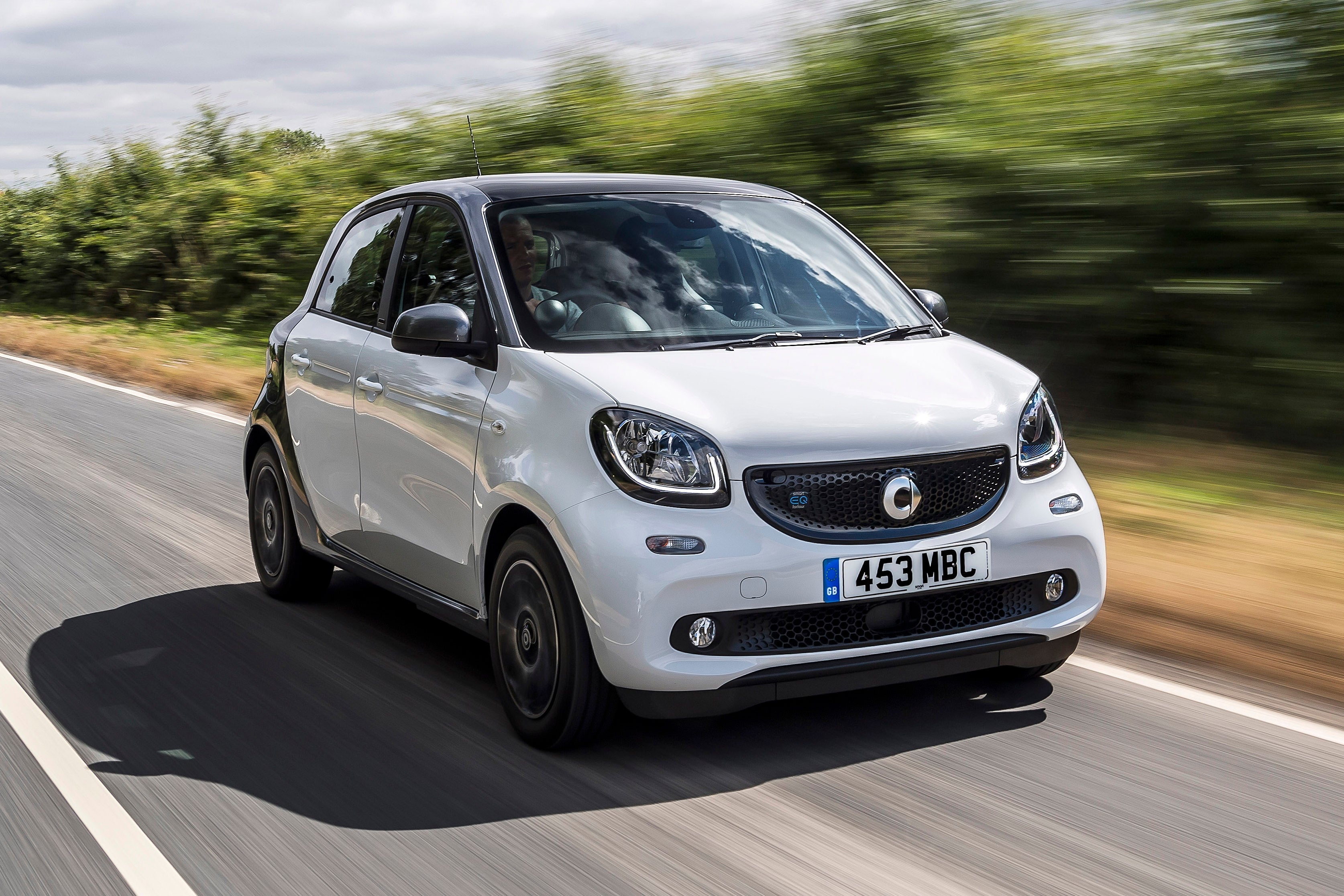Smart EQ Forfour (2019-2022) Review
Written by Andrew Brady
Quick overview
Pros
- Lively low-speed acceleration
- Strong standard specification
- Low running costs
Cons
- Limited range confines it to the city
- Less boot space than the smaller ForTwo
- Barely cheaper than more versatile rivals
Overall verdict on the Smart EQ Forfour
"Smart is probably best-known for its diminutive Fortwo, a city car that is smaller than any other car currently on sale and designed with city life primarily in mind. The Forfour is a slightly bigger car spun off the same platform, this time offering four doors but the same unusual rear-engine, rear-drive layout designed to offer maximum interior space for a given footprint."
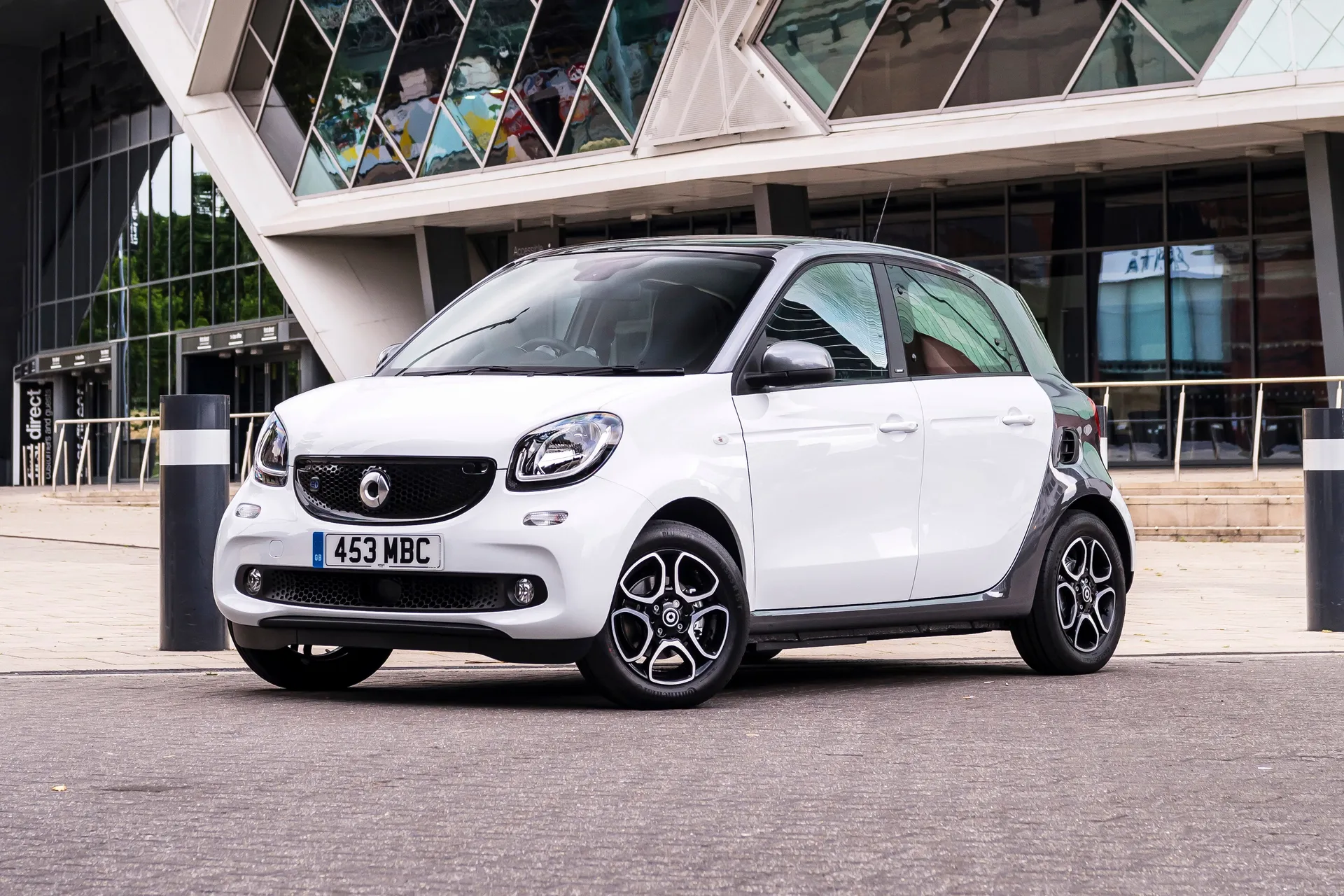
Times have changed however, and the move towards electrification is squeezing out conventional engines. In 2017 Smart introduced EQ versions of the Forfour and the Fortwo, switching out the petrol engine options for an electric motor and battery pack, and sold the two types alongside each other. Now the petrol versions have been discontinued, all new ForFour models are sold as electric cars only.
Despite the switch to electric propulsion, some things remain as before. Originally designed and built in collaboration with Renault, who produced the mechanically-similar Twingo, the Smart EQ Forfour uses the same basic layout of the smaller EQ Fortwo by placing the motor at the rear of the car and driving the rear wheels, unlike the front-engine, front-wheel-drive approach of every other small car on the market.
In the EQ version the electric motor sits in roughly the same place alongside the associated electronics and gearbox, while the battery pack is placed under the floor so it does not impact on passenger or boot space.
The Smart EQ Forfour also shares its electric drivetrain with the Fortwo model, despite being a little larger and heavier. As standard it receives an 82PS electric motor, is placed between the rear wheels with a 17.6kWh battery pack housed under the floor. Because the ForFour EQ was first introduced in 2017 there are two official EV ranges quoted for the car.
Under the old NEDC rules the ForFour EQ claimed a range of 99 miles, but under the more strict WLTP regulations this is reduced to a maximum of 81 miles. That means a realistic every day range of even less than that, putting the Smart EQ Forfour some distance behind its key competitors.
The good news is the switch to electric propulsion hasn’t impacted the amount of space left in the cabin. It’s still a small car of course at less than 3.5 metres in length, but it can seat four adults in reasonable comfort, even if the rear seats are best suited to younger passengers.
One small niggle with the Smart EQ Forfour is that the driver’s seat and steering wheel doesn’t have a large range of adjustment, so taller drivers may find it harder to get into a comfortable driving position. Rather disappointingly, the luggage area only offers 185 litres with the seats in place, less than the identical Twingo and less even than the Smart ForTwo. This does increase to an impressive 975 litres with the seats folded however.
New Smart EQ Forfours come in four trim levels; Passion Advanced, Pulse Premium, Prime Exclusive and Edition One, somewhat confusingly. Thankfully the level of standard equipment is high; even the most basic models is fitted with alloy wheels, rear parking sensors, the all-important height adjustable steering wheel and driver’s seat, plus the Smart Media System with Mirror Link and Android Auto.
The driving experience is not dissimilar to the petrol version, in that low-speed acceleration is strong but higher speeds are more of a struggle. The same goes for the handling, which is suited to urban cut and thrust but less so out on the open road.
The Smart EQ Forfour is still brilliant city car and one of the cheapest electric cars you can buy, but the limited range of the electric powertrain means it is even more confined to it than before. For very specific needs this is fine, but for many buyers it will be too much of a compromise.
Looking for a used car for sale? We've got 100s of Smart Approved Used Cars for Sale for you to choose from, including a wide range of Smart EQ Fortwo models for sale. If you're looking for standard petrol version, you need our Smart ForFour review.
Is the Smart EQ Forfour right for you?
The bottom line is that the Smart EQ Forfour’s range is so limited that long journeys are out of the question - unless you like to stop every 50 miles for a coffee - so it is really a car that only works in the city. It does this well, thanks to its manoeuvrability and good low-speed acceleration, but there are rivals with more range and better comfort.
What's the best Smart EQ Forfour model to choose?
All Smart EQ Forfours come with the same electric motor and battery pack, so unfortunately there’s no options to choose here. In terms of trim levels, the entry-level Passion Advanced has much of most of the standard equipment you might want, including the Smart Media System, LED daytime running lights and the Comfort package that includes the height adjustable steering wheel and driver’s seat.
If you want a higher-spec model, skip the Pulse Premium and go for the Prime Exclusive, which adds heated leather seats, LED headlights, ambient lighting plus automatic headlights and wipers.
What other cars are similar to the Smart EQ Forfour?
Although the Renault Twingo is the sister car of the Smart EQ Forfour and is identical in many ways, Renault do not currently sell an electric version - instead they offer the Renault Zoe, a dedicated electric car. It is significantly more expensive than the ForFour, but it also offers considerably more range and more cabin space too.
Closer in terms of price and execution are the Volkswagen Group triplets - the Volkswagen e-Up, the SEAT Mii Electric and Skoda Citigo e iV - all of which offer more space, a superior driving experience and a good quality cabin. Crucially they are also relatively close in terms of price, so they make the most compelling alternative to the Smart.
Comfort and design: Smart EQ Forfour interior
"Climb into the Smart EQ Forfour and there’s almost nothing to distinguish it from the conventional version, but that’s not exactly a bad thing. In many ways it feels like a bigger car; there’s plenty of light coming into the cabin, the roofline is high and the dashboard doesn’t overwhelm the space, so it’s a relaxing environment for all."
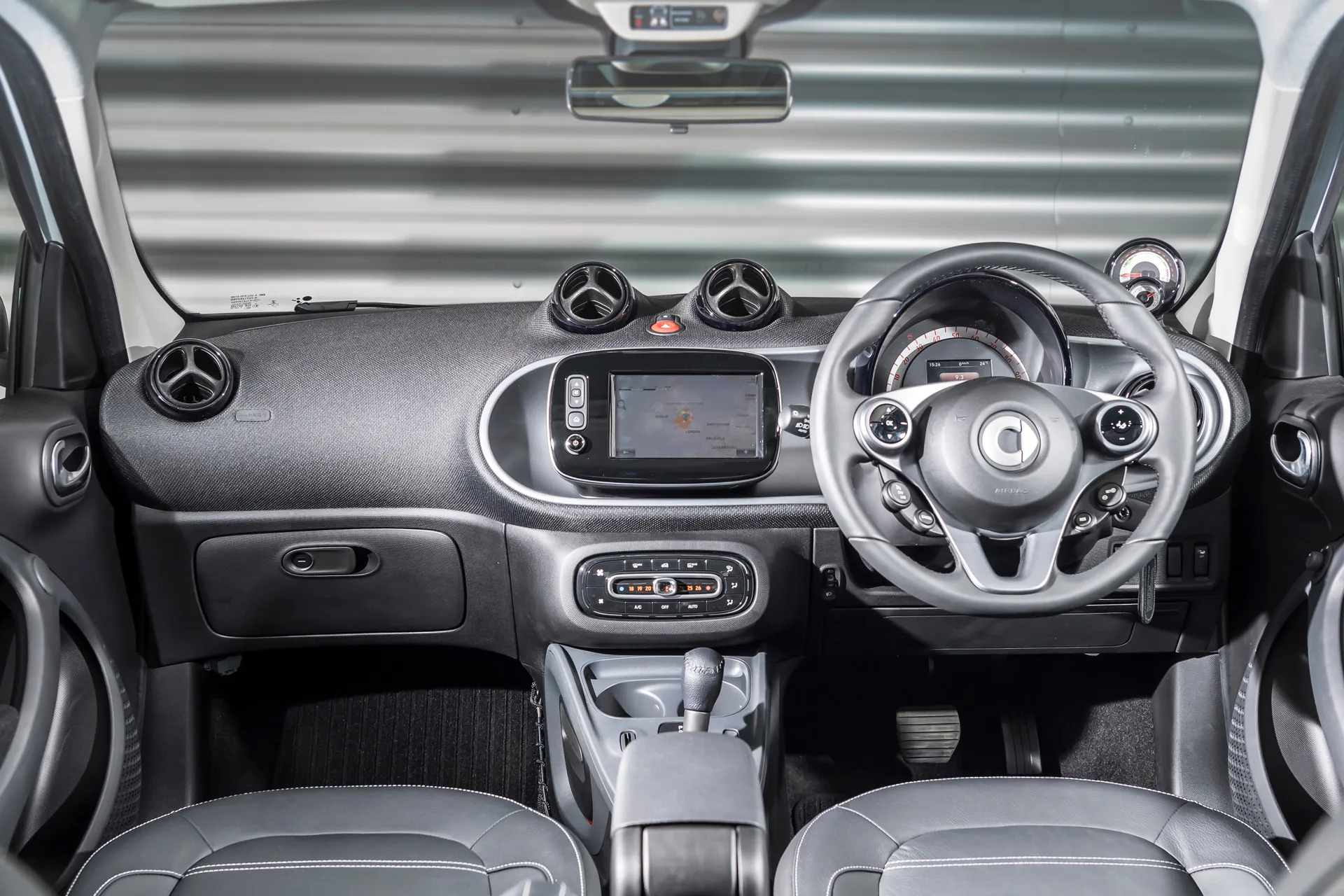
The wacky styling of the outside is also translated into the cabin, because it borrows the design from the smaller ForTwo. That gets you an attractive fabric-covered dash, contrasting colours depending on the model and a mix of materials. There are some cheaper elements here and there but they are reasonably hidden away, so you won’t be bothered by them too often.
The seats look pretty attractive whatever trim level you go for, but they are not as comfortable as they appear. Both front seats are quite firm in their support, so depending on your own frame they can be uncomfortable on longer journeys.
Taller drivers may also find the seat is set too high to get properly comfortable, with the low-set dashboard and small range of adjustment on the steering wheel. It’s a similar story in the back, where the unforgiving nature of the padding won’t be welcomed by your passengers.
Quality and finish
The Smart brand is designed to be an offshoot of Mercedes-Benz, so while it’s not intended to be quite as posh as the premium brand, it is intended to be a cut above the riff-raff - and it’s at least partially successful in this respect.
The most obvious example is the dashboard, which is quite different to the usual slab of grey plastic you get in small cars. Even if you go for a basic version in Passion trim, it feels at least a little bit special. There is a good mix of materials and finishes, like gloss black details contrasting with the fabric covering on the dashboard - small things that do make a difference.
It’s not all good news unfortunately, as some penny-pinching has taken place in terms of the quality of some of materials. That’s true for every other car in this sector, but this also reflects that the Smart EQ Forfour isn’t a totally premium car.
Smart’s relationship with Renault is also evident (the Smart ForFour and Renault Twingo are sister cars) with the occasional item of Renault switchgear dotted around the cabin. The ForFour has also become more conservative in its old age, with less choice in terms of adding colour to the cabin than on earlier models.
Infotainment: Touchscreen, USB, nav and stereo in the Smart EQ Forfour
Unlike older versions of the ForFour, the Smart EQ Forfour model benefits from a single specification infotainment as standard across the range, which means you don’t have to decide which version to choose or pay extra for the privilege.
As standard the Smart EQ Forfour gets the Smart Media System, which is made up of a 7-inch touchscreen, TomTom navigation including live services such as traffic reporting, Android Auto and Mirror Link and a DAB tuner.
At present, the system doesn’t offer Apple CarPlay, although Smart says it will be offered later on in the vehicle’s lifetime, so it would be worth checking with your friendly dealer if this is going to be a dealbreaker.
The system works pretty well, responding to the inputs of the driver accurately and the graphics are simple and easy to read. You can also use the steering wheel controls to operate certain functions. It is worth noting that this system has been in use for a while, so it’s not the freshest, but it should provide enough to meet the needs of most buyers. You also get three years’ subscription to the TomTom Live services, but it will require a subscription outside of that period.
Space and practicality: Smart EQ Forfour boot space
The big difference between the Smart EQ Forfour (and ForTwo) and its rivals is the rear-engine, rear-drive arrangement. The theory goes that by putting all the major mechanical components way out back, it means you can have a shorter bonnet and free up more space inside the car for people and luggage, whilst still keeping the overall dimensions as short as possible - saving space on the road.
The total amount of room in here may not be earth-shattering, but it does manage to achieve the goal of maximising the ForFour’s footprint. Front seat occupants still get the best deal of course, with plenty of legroom available even for taller passengers, while the headroom is also impressive, but there’s still enough space to accommodate two adults in reasonable comfort.
It’s a shame that the front seats, in particular the driver’s seat, are set so high, as this can leave taller drivers feeling wedged under the dashboard despite the actual legroom on offer.
Getting into the back is helped in part by the fact that the rear doors open to almost 90 degrees, although the actual size of the aperture and the amount of space in the footwell isn’t any better as a result.
Less impressive is the amount of boot space available with the Smart EQ Forfour, which is a miserly 185 litres - less even than the smaller ForTwo. You can tilt the rear-seat backrest to 90 degrees to increase the space to 219 litres, but that makes them uninhabitable to all but the generous.
However, you can fold the rear seats to give you 975 litres of space in total, and even fold the front passenger seat forward to swallow loads of up to 2.3m in length. Some space is also taken up by the charging cables, which you’d be mad to leave home without.
Anyone hoping for a second ‘boot’ up front will be disappointed; the space is taken up with a crash structure and can’t be filled with your stuff. Storage space in the cabin is acceptable but not amazing, with a modest glovebox and two cupholders.
Handling and ride quality: What is the Smart EQ Forfour like to drive?
"You don’t get many rear-engined cars these days, chiefly because front-engined, front-wheel-drive layouts became the norm - mainly for simplicity but also in part because they were easier to drive."
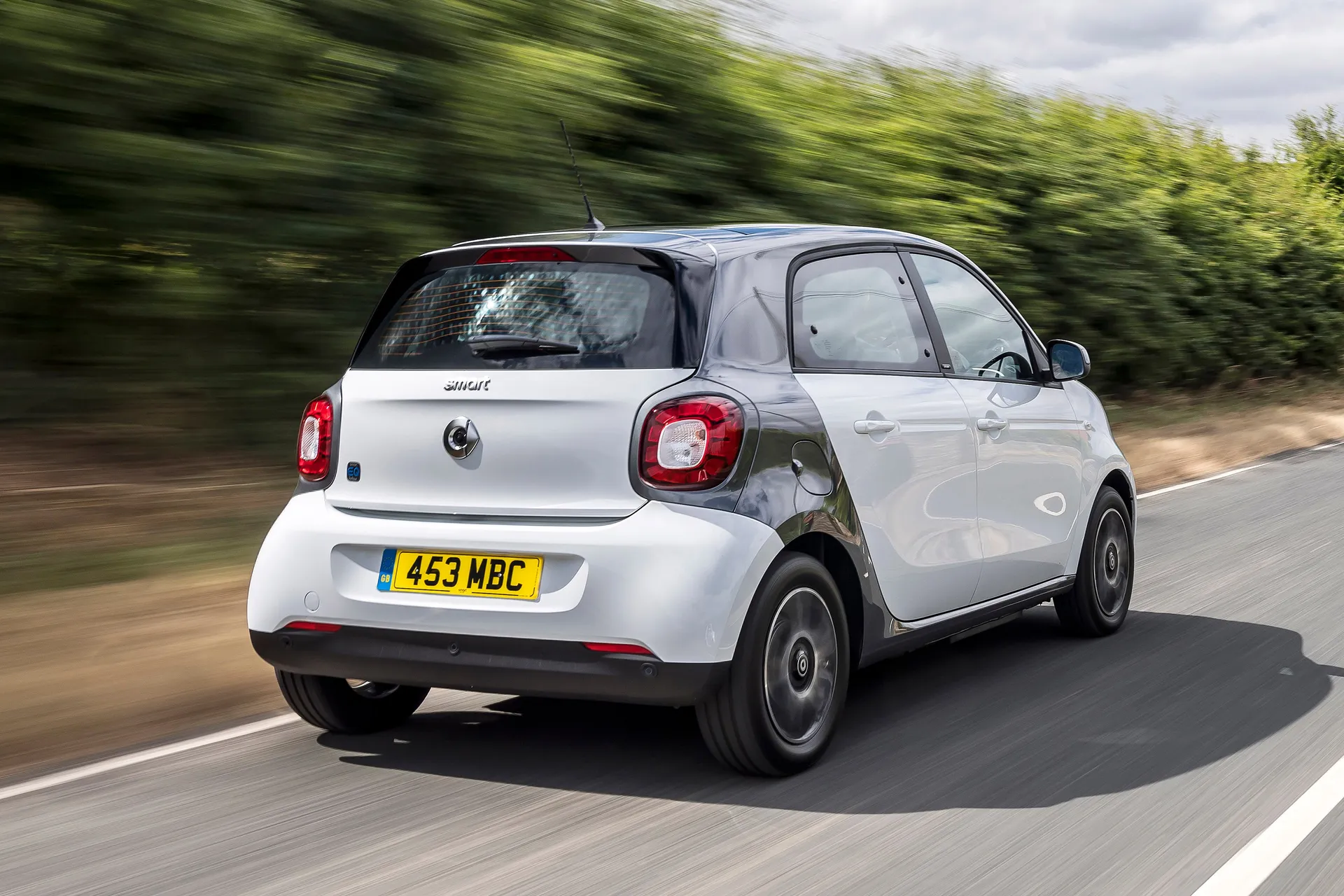
With all the weight at the back and the drive going to the rear wheels, it’s easy to see why an inexperienced driver might see one as a tricky prospect, but the reality is that Smart has effectively engineered out any of the issues you get with a rear-engined car.
One of the benefits of switching up the standard arrangement is that you get a super-tight turning circle with the Smart EQ Forfour, thanks to the absence of a big lump of metal in the nose allowing the front wheels to turn to a greater degree. That means you’ll have to do fewer three-point turns and parking is easier too, also a bonus for inexperienced drivers.
It is important to note though that the steering itself is low-geared to stop drivers getting themselves into bother. Power steering means it is light, but it takes several turns to go from lock to lock. It stops the ForFour from being as much fun to drive as it could be, but for most buyers this is the sensible option. There is fun to be had still, particularly as you can feel the car moving around in corners before the ESC kicks in, but it is safe rather than thrilling.
More disappointing is the Smart EQ Forfour's ride quality, which is inconsistent and a little below the class standard. The suspension setup is relatively stiff, so that at lower speeds in particular, sharper bumps are felt more easily in the cabin. It’s less of an issue at higher speeds and over longer undulations, but for a car with its primary role, it’s a little disappointing that it is not more comfortable in these conditions.
What engines and gearboxes are available in the Smart EQ Forfour?
There’s just the single motor and battery pack option for the Smart EQ Forfour, again shared with the smaller ForTwo version. As standard, you get an 82PS electric motor that drives the rear wheels through an automatic gearbox (there’s no manual option), and power is provided to the motor by a 17.6kWh battery mounted low down in the centre of the car.
Like most electric cars, the motor provides strong torque - 160Nm - from zero revs, giving it the kind of lively acceleration that you want in city driving. There’s no need to shift gears either, you just squeeze the accelerator and enjoy the ability to keep up with traffic.
It doesn’t translate to good performance at all speeds though. Get up to higher speeds on main roads and there’s less go available. Get out onto the motorway and the EQ really begins to struggle. It’s capable of 81mph, but it will take you a while to get there and it will have some difficulty maintaining that speed up hills.
Like most other electric cars the Smart EQ Forfour also feeds energy back into the battery when you come off the accelerator through regeneration. You can modulate this a little by pressing the brake pedal, but sometimes it is hard to be smooth and avoid grabbing the actual brakes, which can be irritating in busy traffic.
Refinement and noise levels
One of the main benefits of switching to electric power with a pre-existing car is that you instantly get a reduction in noise levels and an increase in refinement. This is partially true for the Smart EQ Forfour compared to the standard ForFour, not least because the petrol engine is quite a vocal one, but it is far from a complete success.
At lower speeds noise levels are commendably low. Accelerate away and all you get is a faint whine from the powertrain which is not nearly loud enough to be irritating, and the lack of noise is a plus point when in traffic - it’s much easier to then hear what’s going on around you.
However, it’s much less impressive as the speeds increase. The powertrain remains relatively quiet, but the basic noise levels of the ForTwo itself are shown into sharp relief. Tyre noise starts to kick up at higher speeds alongside an increase in wind noise - even more so on the Cabriolet model - so that all the benefit of the electric powertrain is effectively lost.
Safety equipment: How safe is the Smart EQ Forfour?
EuroNCAP tested the Smart ForFour when it was first launched in 2014, and it scored a strong four-star result overall. It scored 78 per cent for adult protection and 77 per cent for child protection, and no doubt helped by the rear engine configuration it achieved 65 per cent for pedestrian mitigation. EuroNCAP also awarded the ForFour 56 per cent for safety assist.
As standard, all ForFour models are fitted with ESC, front, side and curtain airbags as well as seat-belt pre-tensioners in the front seats only. A speed limiter is also fitted to all models, which is a useful safety feature even if it requires the driver to resist the temptation to turn it off, and hill start assist is also standard across the range.
One benefit of the Smart EQ Forfour compared to the standard car is that, on new models at least, automatic emergency braking is fitted as standard on all versions, a very useful safety feature particularly for a car that will spend most of its time in town and in traffic.
All versions of the Smart EQ Forfour are fitted with a tyre inflation kit as standard, while a space saver or full-size spare is not an option, which for some buyers may be something of a sticking point. The main issue is that there is nowhere for the extra wheel to go, as the space under the boot floor is taken by the engine.
Maximum EV range in the Smart EQ Forfour
Usually the first question that gets asked of an electric car, the range is a crucial factor and on this front the Smart EQ Forfour is somewhat disappointing. The 17.6kWh battery is considerably smaller than rival offerings - the SEAT Mii for example has a battery with almost twice the capacity - and this restricts the range severely.
Official figures give the Smart EQ Forfour a range of 80.7 miles under the stricter WLTP rules. That gives it an effective real-world range of 70 miles at most, and considerably less in adverse weather conditions. That means the EQ is not a realistic prospect for longer-distance travel.
Charging times: How much does it cost to charge a Smart EQ Forfour?
"The plus side with every electric car is that it is (usually) considerably cheaper to charge up a battery than it is to fill a tank with fuel, although in this instance you’ll have to charge it up several times in order to cover the same distance as petrol will carry you."
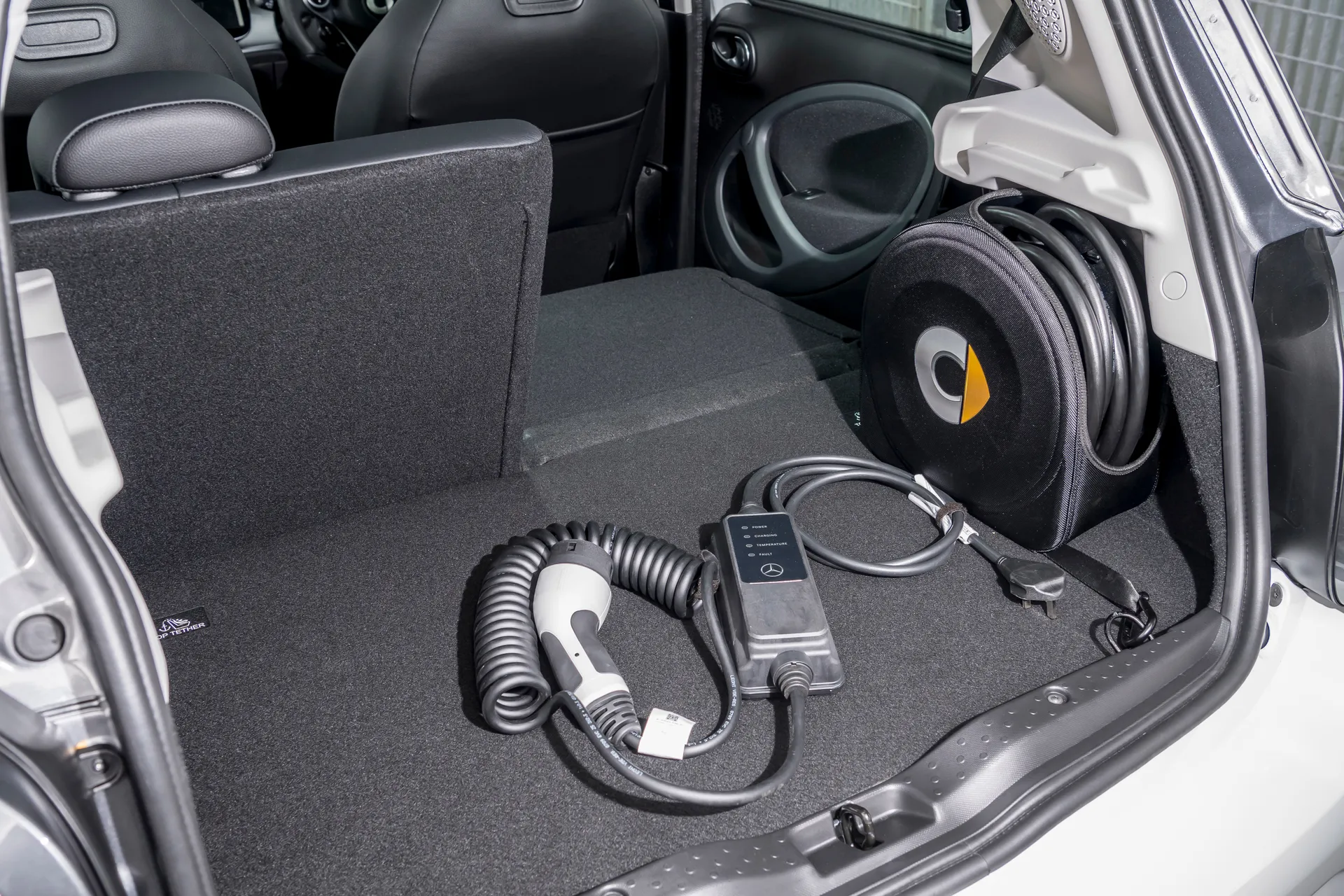
Because the Smart EQ Forfour has a small battery in comparison to some rivals, it can get to a good level of charge quite quickly. It can take a charge of up to 22kW at a public charging point and will go from 10 per cent to 80 per cent battery capacity in 40 minutes.
Smart are partnered with BP Chargemaster in the UK, and with Homecharge box installed it will go from 10 per cent to 80 per cent in 3 hours and 18 minutes. An overnight charge from a regular 3-pin socket takes 8.5 hours. Smart says a home charge can cost under £2.50, and if you buy new you get a two-year membership to Polar Plus where a charge can cost under £3.00.
Insurance groups and costs
The Smart EQ Forfour falls into a relatively narrow range of groups depending on the trim level and the age of the vehicle. All brand-new ForFour EQs fall into group 11 regardless of the specification, whereas older versions are split between groups 9 and 10, with the Passion Advanced trim falling into the former category.
Because there’s little difference between the versions and ages, there’s not a great deal of money to be saved on your premium by choosing one or the other, although a newer version with automatic emergency braking is a sensible upgrade.
VED car tax: What is the annual road tax on the Smart EQ Forfour?
Happily the current rules on VED mean that zero emission cars pay zero road tax, so the whole of the Smart EQ Forfour range will cost you zero pounds a year. That may change of course, but as we are being encouraged to switch to EVs this is unlikely to change significantly for a while yet.
Also, the ForFour is sufficiently cheap that there’s no chance of it costing over £40,000 when new - a figure that attracts a VED penalty in the first year from the government even if it is a zero-emission electric car.
How much should you be paying for a used Smart EQ Forfour?
"The EQ version of the ForFour was introduced later in the car’s life, and even though the popularity of electric cars has boomed in recent years it was still seen as something of a niche product - so there are not a huge number of examples to choose from."
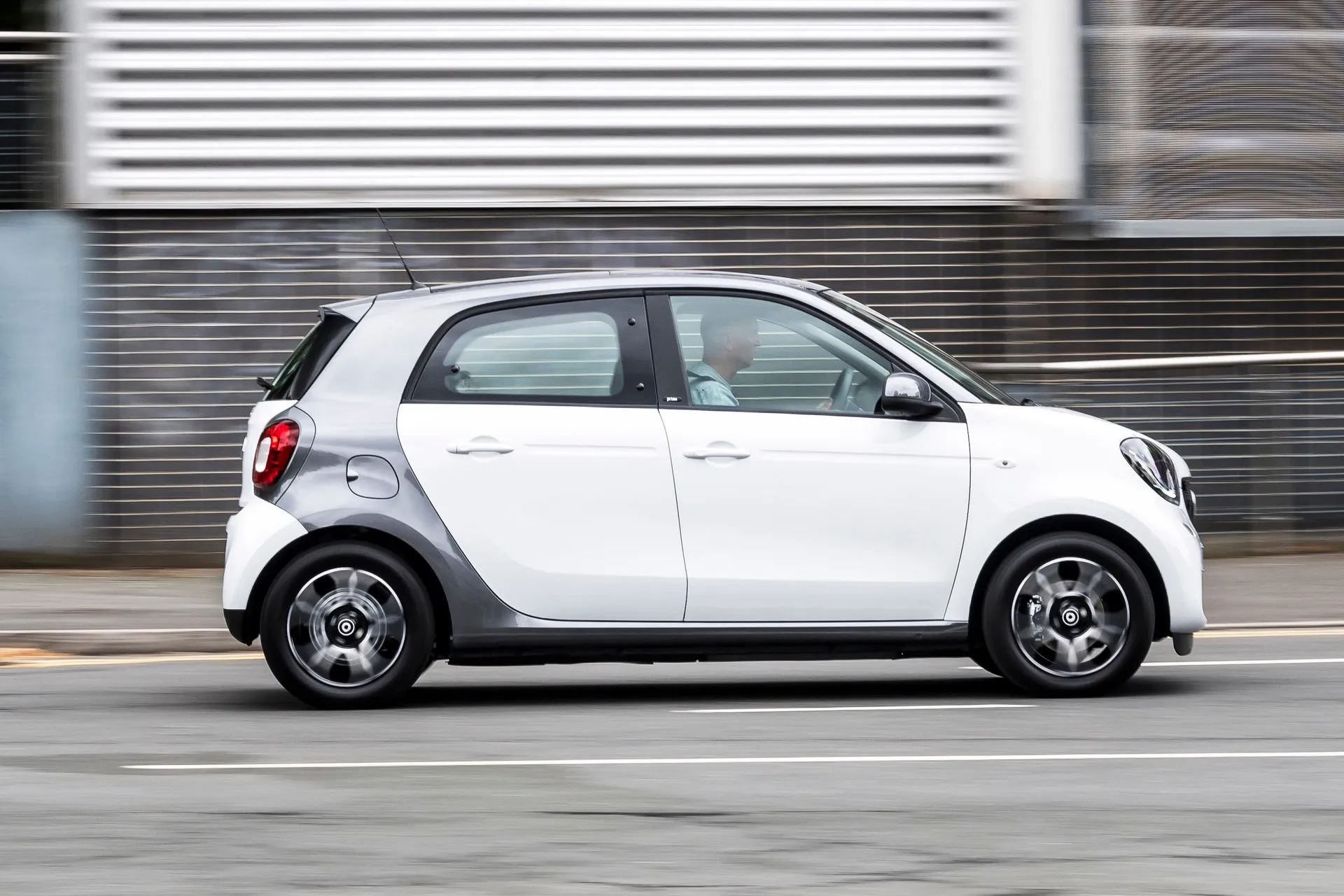
That said, a quick search of the HeyCar classifieds turned up several examples over a wide price range. There was a good selection of 2020 examples available, some with delivery mileage. We found a 2020 car in Prime Exclusive specification with less than 500 miles on the clock for £18,000.
As for older cars, 2018 examples are down around the £14,000 mark, which is a useful saving over a newer car. We found a 2014 example with still less than 3,000 miles on the clock, in Prime Premium spec for £13,500, but given the relatively short supply it pays to shop around.
Trim levels and standard equipment
That said, a quick search of the HeyCar classifieds turned up several examples over a wide price range. There was a good selection of 2020 examples available, some with delivery mileage. We found a 2020 car in Prime Exclusive specification with less than 500 miles on the clock for £18,000.
As for older cars, 2018 examples are down around the £14,000 mark, which is a useful saving over a newer car. We found a 2014 example with still less than 3,000 miles on the clock, in Prime Premium spec for £13,500, but given the relatively short supply it pays to shop around.
Ask the heycar experts: common questions
Do they still make the Smart EQ Forfour?
Is the Smart EQ Forfour a good car?
What is the range of the Smart EQ Forfour?
Get our latest advice, news and offers
Keep me updated by email with the latest advice, news and offers from heycar.
By submitting you agree to our privacy policy
